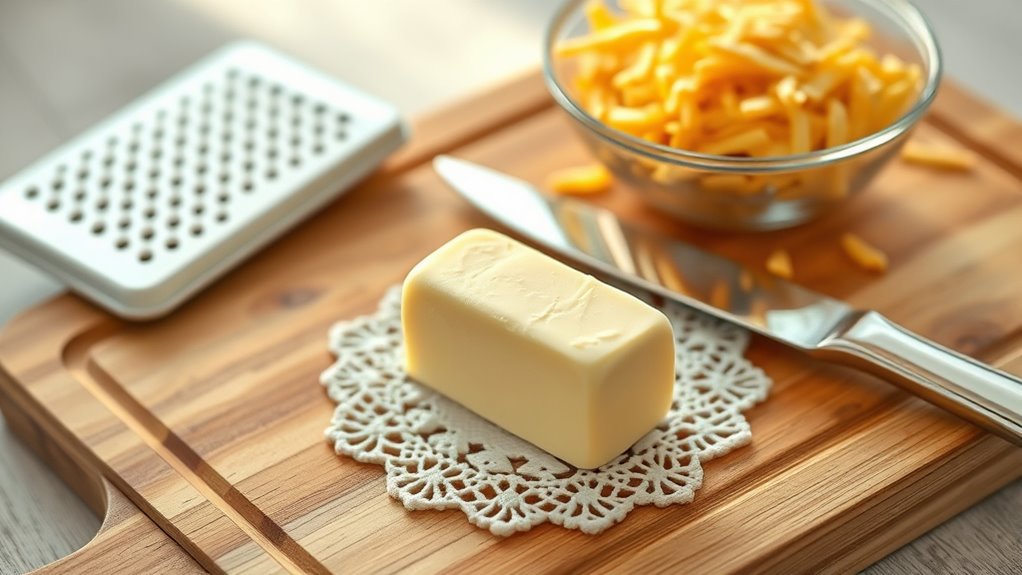To soften butter quickly without melting it, try a few simple methods. Cut the butter into small cubes or grate it to expose more surface area. Another effective approach is to use a warm water bath; just wrap the butter and submerge it for about 5-10 minutes. If you’re in a hurry, microwave the butter on low power in short bursts while checking frequently. Want more tips to get that perfect spreadable butter?
Key Takeaways
- Cut butter into smaller cubes to increase surface area for faster softening at room temperature.
- Grate butter using a cheese grater to achieve instant softening without the risk of melting.
- Submerge wrapped butter in warm water for 5 to 10 minutes to soften gently without altering its texture.
- Use a rolling pin between parchment paper to flatten and soften butter quickly using hand warmth.
- Microwave butter at low power in short intervals, checking frequently to prevent melting.

Whether you forgot to take your butter out of the fridge or need it softened for a recipe, there are several quick methods to get it ready. Butter straight from the fridge can be too hard to spread or mix, so knowing a few alternative softening methods can save you time and frustration.
One of the easiest methods is to cut your butter into smaller cubes. By slicing it, you increase the surface area, allowing the butter to soften faster at room temperature. If you’re in a hurry, you can even grate the butter using a cheese grater, which will turn it into small flakes that soften almost instantly. Just make sure to keep an eye on it, as it can melt if left out too long.
Cutting butter into smaller cubes or grating it helps soften it quickly at room temperature, making it easier to use.
Another effective method is to use warm water. Fill a glass or bowl with warm water, and place your wrapped stick of butter inside for about five to ten minutes. Make sure the water isn’t boiling hot, as you don’t want the butter to melt—just warm enough to do the trick. This method works well because it gently warms the butter without compromising its texture.
If you have a microwave, you can use it, but you need to be cautious. Set it to a low power setting and heat the butter in short intervals, like five seconds at a time. Check it frequently to ensure it’s softening and not melting. This is a quick way to soften butter, but it requires your attention to avoid disaster.
For those who prefer a more hands-on approach, try using a rolling pin. Place your butter between two sheets of parchment paper or wax paper and roll it out. The heat from your hands and the pressure will soften the butter quickly, and you’ll end up with a flat, easy-to-use piece.
Lastly, if you’re often caught in a butter dilemma, consider the way you store it. Leaving butter in a butter dish on the counter can help keep it soft and spreadable for daily use, provided your kitchen isn’t too warm. However, be mindful of the storage conditions, as butter can absorb odors from other foods. Additionally, the optimal angles for pinball machines can influence gameplay, just as the optimal methods for softening butter can enhance your baking experience.
Frequently Asked Questions
Can I Soften Butter in the Microwave?
Yes, you can soften butter in the microwave using the microwave method, but you need to be careful. Set your microwave to a low power setting and heat the butter in short bursts of about 5-10 seconds. Check it frequently to avoid melting it. This quick softening technique works well for recipes that require soft butter, but remember, you want it softened, not melted! Use it wisely to achieve the perfect texture.
How Long Does Softened Butter Last?
Softened butter lasts about 1 to 2 days at room temperature if you store it properly. Make sure to keep it in an airtight container to prevent it from absorbing odors and going rancid. If you need it to last longer, consider refrigerating it, which can extend its shelf life to several weeks. Just remember, when butter’s softened, it’s best to use it quickly for the best flavor and quality.
Is Room Temperature Butter Safe to Eat?
You’d think room temperature butter would be a dangerous game, but it’s actually safe to eat. Just be mindful of butter storage; keep it covered to prevent contamination. If you’re worried about spoilage, you might consider butter alternatives like margarine or ghee, which have longer shelf lives. So next time you leave that butter out, don’t stress—it’s perfectly fine, as long as you give it a little TLC!
Can I Freeze Softened Butter?
Yes, you can freeze softened butter! Just make sure it’s properly wrapped to prevent freezer burn. When you’re ready to use it, simply transfer the butter to the fridge to thaw gradually. Freezing butter is a great way to extend its shelf life, but remember that it’s best to use it within six months for maximum flavor. Proper butter storage ensures you always have some on hand for your baking needs!
What Recipes Require Softened Butter?
You’ll find that many recipes require softened butter, especially in baking. Cookies, cakes, and frostings often call for it to achieve the right texture. When you’re looking for butter substitutes, remember that softened coconut oil or margarine can work well. For baking tips, make sure your butter is at room temperature to blend easily with sugar and other ingredients, ensuring a light and fluffy result. Happy baking!
Conclusion
With these simple tricks, you can transform rock-hard butter into a creamy delight faster than a cheetah on roller skates. Whether you’re baking a masterpiece or just spreading a quick snack, you’ll never have to endure the agony of cold butter again. So go ahead, release your culinary prowess and impress everyone with your lightning-fast butter-softening skills. You’ll be the superhero of the kitchen, cape not required!










